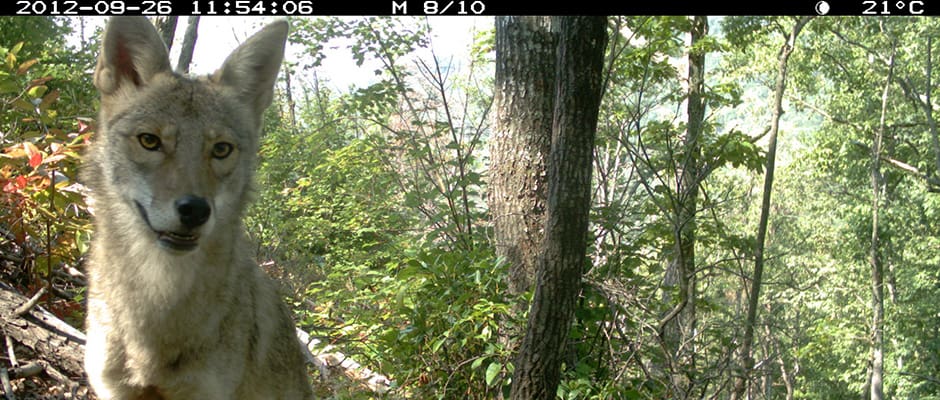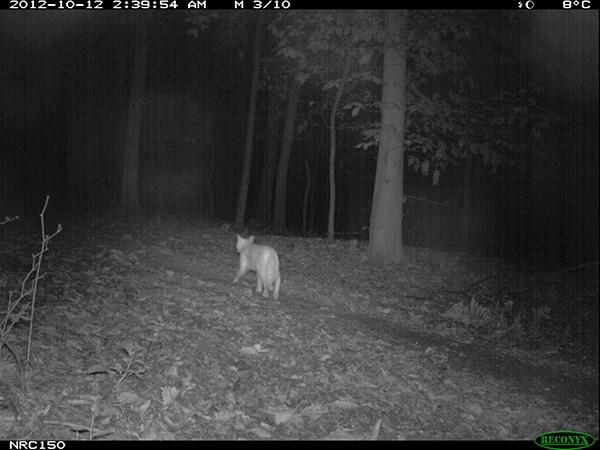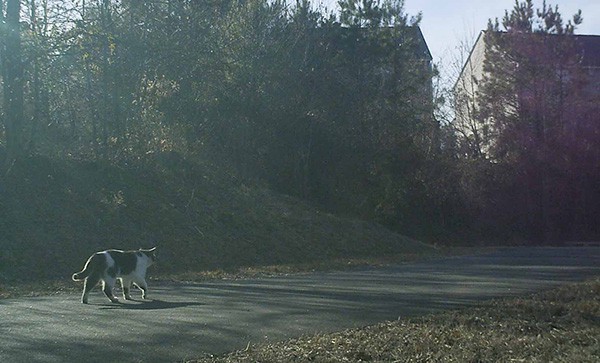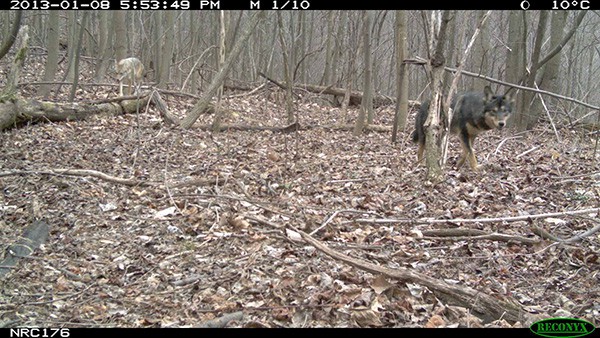Share this article
House Cats Avoid Coyote Haunts: Wild Cam Series
There’s a trick to conserving nine lives, and a new camera trap study shows that it may involve domestic felines having prudence when it comes to keeping out of coyote habitat.
“The pattern was relatively straightforward and obvious,” said TWS member Roland Kays, a professor at North Carolina State University and the lead author of a study in the Journal of Mammalogy that shows domestic cats (Felis catus) tend to steer clear of areas that harbor coyotes (Canis latrans). “Most of the nature preserves that we surveyed had no cats.”
This newest Wild Cam photo essay of The Wildlife Society was one of the first studies of the larger eMammal Project, a citizen scientist initiative led by the Smithsonian Institute and NCSU to document animals in the east and eventually across the country. All camera trap images are courtesy of the eMammal Project.
Cat owners sometimes favor their pet felines for their mousing abilities, but the animals aren’t particularly picky when it comes to small animals. Housecats are estimated to kill billions of wild birds every year in the U.S. alone as well as any number of small mammals, lizards or other animals, Kays said. The team wanted to know if this kind of predation extended to national parks where wildlife professionals are working to protect species in the U.S. and Kays said it was “some relief” that coyotes seemed to keep the cats at bay in some wilderness areas.
Most coyote images collected by the team show solitary animals, but occasional shots show the animals hunting in packs. “When we did our statistical analysis, the number of coyotes seen at a site was the best explanatory variable,” Kays said. Aside from Raleigh’s urban areas, camera traps took photos in 32 protected sites like state or national parks and noticed immediately that there were rarely images of cats in areas that appeared to have lots of coyotes.
Even areas like Rock Creek Park located in the heart of Washington, D.C. had very few cat shots. Only a single brave cat, walking into the darkness, was captured on cameras compared to 125 coyote pictures taken in the area. “There’s no doubt that coyotes eat cats,” Kays said. “Some cats are stupid, but other cats figure it out.” The smart cats stay out of the wild places where coyotes roam.
The work drawn on from this study involved around 500 volunteers putting cameras in more than 2,000 locations across six states from South Carolina to Maryland. The volunteers, including middle school and university students, were overseen by wildlife professionals such as Kays, pictured here kneeling on the far left. The professionals helped the volunteers put the millions of images they collected through the eMammal software.
Cats were detected 300 times more often in residential yards, where coyotes were rarely captured on film. “We found not many coyotes in people’s backyards. The places they overlap are the places in the small urban woodlots in Raleigh,” Kays said. Aside from the risk cats present to local microfauna, he said that felines are also in danger of being attacked or eaten when they live near wild areas. “You should really keep your cat indoors for your cat’s health,” he said.
Recent research by member of The Wildlife Society Stanley Gehrt showed that coyotes have adapted to living in heavily urbanized areas of Chicago. But Kays said coyotes are relatively newer in cities like Raleigh, where they still appear to stick to wilderness areas. Nonetheless, coyotes sometimes approach buildings — this one was taken from a camera set up by middle school volunteers. “In five years I’m sure they’ll be more urban than they are today,” Kays said.
Many coyotes in the east, such as the one pictured here on the left, are hybridized with domestic dogs. “In some ways coyotes are kind of an invasive species in the east,” Kays said. But many wildlife ecologists see them as the closest thing the region may get to the former wolf population.
“In areas like Australia or New Zealand that don’t have larger native predators, the cats are a huge problem,” Kays said. “[This study] shows that larger predators on the landscape can maintain the balance of nature by keeping invasive species at bay.” Knowing where domestic cats hunt can also help wildlife professionals asses the risk to local fauna, he added.
This photo essay is part of an ongoing series from The Wildlife Society featuring photos and video images of wildlife taken with camera traps. Check out other entries in the series here. If you’re working on an interesting camera trap research project and have photos you’d like to share, email Joshua at jlearn@wildlife.org.
Header Image:
A coyote looks at a camera trap in South Mountain Gameland, N.C.
Image Credit: eMammal Project















